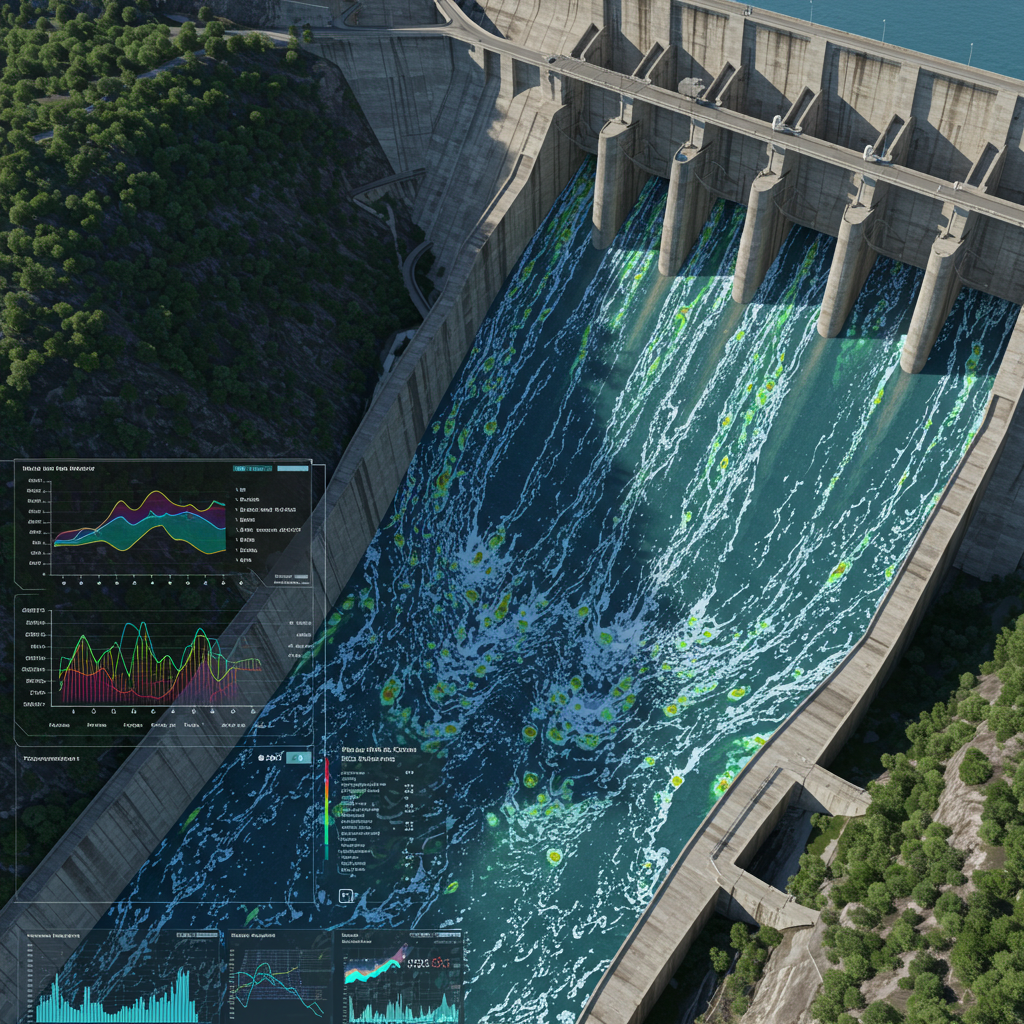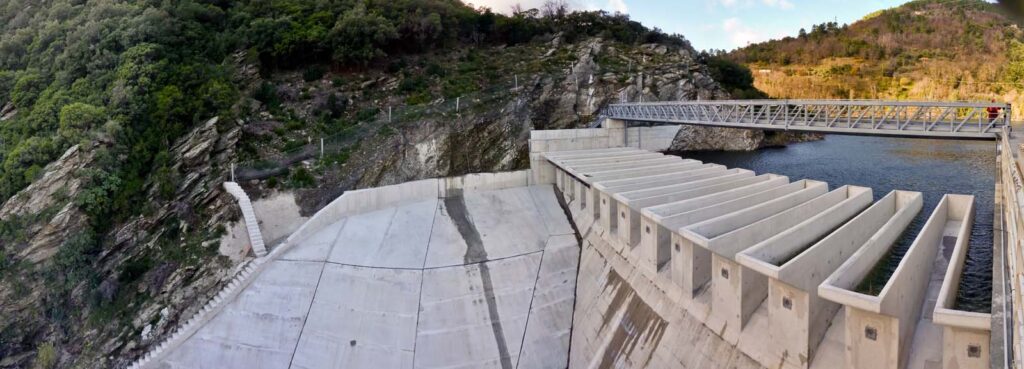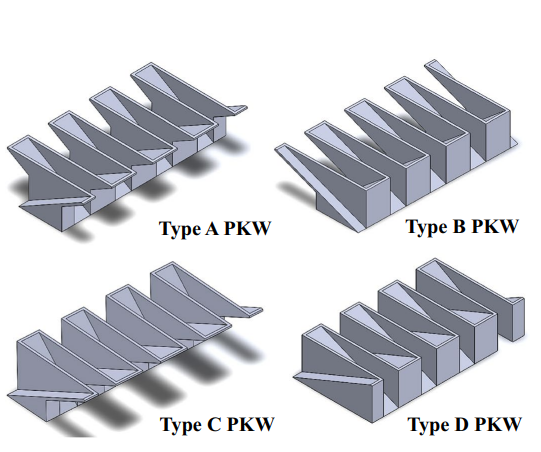With rapid change in climate, the water management has become a more challenging task. As extreme weather events become more frequent, hydraulic engineers face the complex task of designing structures that can handle variable water flows efficiently. This is where Piano Key Weirs (PKWs) have emerged as a revolutionary solution to this problem.
Unlike traditional linear weirs, PKWs feature a unique piano key-like design that significantly increases the effective length of the weir within the same footprint. This ingenious design allows for higher discharge capacity at lower upstream water levels, making them particularly valuable for flood control and dam safety. When a flood event occurs, these structures can pass more water at a lower head, reducing the risk of dam overtopping and potentially catastrophic failures.
The relationship between weir head and discharge in PKWs follows a formula articulated by Henderson in 1996, where discharge equals (2/3)Cd√(2g)Ht^1.5, with Cd representing the discharge coefficient, g the gravitational acceleration, and Ht the total upstream head. This relationship forms the theoretical foundation for understanding PKW performance, though the complex geometry makes precise predictions challenging without extensive physical modelling or advanced computational techniques.
The rehabilitation of aging dams has become an increasingly pressing issue on a global scale, as many of these infrastructures approach or surpass their originally designed lifespan. As concerns about safety and efficiency grow, engineers face the critical challenge of enhancing spillway capacity to accommodate changing environmental conditions and increased water flow, all while minimizing the need for significant reconstruction. This is where, Piano Key Weirs (PKWs) present an effective and innovative solution. These structures can be seamlessly integrated onto existing dam crests, allowing for a substantial increase in discharge capacity. The advantage of PKWs lies not only in their effectiveness but also in their ability to be installed with minimal disruption to the dam’s primary structure, which is crucial for maintaining the overall integrity and reliability of these vital infrastructures.
For example, the rehabilitation efforts at the Malarce Dam in France exemplify the successful application of PKWs. This project involved sophisticated engineering techniques to enhance the dam’s ability to manage increased water flow while adhering to safety standards. Similarly, the Ouldjet Mellegue Dam in Algeria also adopted PKWs to improve its discharge capacity. In both cases, the use of PKWs allowed for significant upgrades without necessitating extensive modifications to the existing dam structure, thereby preserving the original design’s stability and functionality.
Piano Key Weirs represent a significant evolution in hydraulic design, with each geometric parameter playing a crucial role in performance. The intricate geometry includes multiple elements such as weir height (P), total crest length (L), inlet and outlet key widths (Wi and Wo), PKW cycle width (Wu), total width (W), base length (Bb), overhang lengths (Bo and Bi), lateral crest length (B), cycle number (N), and wall thickness (Ts).
Based on their configuration, PKWs are classified into four distinct types. Type A features symmetrical overhangs in both upstream and downstream directions, creating a balanced profile. Type B includes only upstream overhangs, Type C has only downstream overhangs, and Type D has no overhangs at all. Each type offers different hydraulic performance characteristics suited to specific project requirements.
Previous research work has identified several key geometric ratios that significantly impact discharge efficiency. Lempérière and colleagues (2011) found that the ratio of crest length to width (L/W) strongly influences discharge capacity, with optimal values ranging between 4 and 5. Leite Ribeiro and team (2012) discovered that PKWs perform best when the inlet-to-outlet width ratio (Wi/Wo) is maintained at approximately 1.60. Anderson and Tullis (2013) observed that discharge efficiency plateaus at Wi/Wo ratios of 1.25 and 1.50, suggesting diminishing returns beyond these values.
Several comparative studies between different PKW types have yielded valuable insights for designers. Anderson and Tullis (2012) found that Type A PKWs exhibited an average of 8.20% greater discharge capacity than Type D PKWs under equal crest length conditions. Cicero (2016) demonstrated that Type B PKWs outperformed Type A by 5% to 15%, and showed up to 15% greater efficiency than Type C configurations.
These technical details might seem abstract, but they translate directly to practical benefits. A well-designed PKW can handle significantly more water during flood events, potentially preventing downstream flooding in communities near rivers or dams. This performance improvement can mean the difference between effective flood management and catastrophic failure during extreme weather events.
Traditional approaches to predicting PKW discharge typically rely on physical modelling or complex computational fluid dynamics simulations. However, these methods are time-consuming, expensive, and often require specialized expertise and facilities. To address these challenges, artificial intelligence offers a revolutionary alternative.
The article discusses about a study conducted by Abdelrahman Kamal Hamed and Mohamed Kamel Elshaarawy from Horus University, Egypt, in developing two AI models, namely, Artificial Neural Network (ANN) and Gene Expression Programming (GEP), to predict discharge from symmetrical Piano Key Weirs. The study uses a dataset comprising 476 experimental records from previous studies, and trained these models to recognize patterns between geometric parameters (PKW key widths, PKW height) and hydraulic conditions (upstream head).
The ANN model employed in this study processes input data (geometric parameters and hydraulic conditions) through multiple layers of interconnected nodes. Each connection has an associated weight that gets adjusted during training to minimize prediction errors. The final model configuration can capture complex nonlinear relationships between inputs and outputs that would be difficult to express mathematically. The GEP model takes a different approach, automatically generating and evolving mathematical expressions to predict discharge. It starts with simple expressions and gradually increases complexity through genetic operations like mutation, recombination, and selection. The final output is an explicit mathematical formula that can be directly implemented in engineering calculations without specialized software.
During the training phase, the ANN model demonstrated remarkable accuracy with a determination coefficient (R²) of 0.9997 and a Mean Absolute Percentage Error (MAPE) of just 0.74%. The GEP model also performed admirably with an R² of 0.9971 and a MAPE of 2.36%. When tested against new data, both models achieved an R² value of 0.9376, confirming their reliability for real-world applications.
Further, the research utilizes SHapley Additive exPlanations (SHAP) and Partial-Dependence-Plot analyses, to determine that upstream head exerted the greatest influence on discharge prediction, followed by PKW height and key width. This insight helps engineers understand which parameters deserve the most attention during design and monitoring.
This research marks a key advancement in AI applications for hydraulic engineering, though it’s only the start. Considering future direction and broader implications, the upcoming studies may adapt these models for other PKW types, include factors like crest shape or approach conditions, or link them with weather prediction for real-time flood management. The wider implications reach all hydraulic structures. Similar strategies could improve various water management systems, from spillways to irrigation networks. As climate change elevates hydrological uncertainty, these AI tools gain value in developing resilient water infrastructure. This article discusses about a study, which shows how traditional hydraulic engineering can benefit from modern data science, emphasizing the necessity for new engineers to acquire skills in both areas to tackle complex water issues effectively.
In conclusion, Piano Key Weirs represent an innovative solution to increasing discharge capacity in water management systems, and artificial intelligence is now enhancing their application through improved prediction capabilities. The research by Hamed and Elshaarawy demonstrates that both ANN and GEP models can reliably forecast discharge over symmetrical PKWs, with the ANN model showing particularly impressive accuracy.
These technological advancements offer practical tools for hydraulic engineers and water resource managers, enabling more efficient design, operation, and management of water infrastructure. As we face increasing hydrological challenges due to climate change and growing water demands, such innovations become essential for creating resilient water systems that protect communities and optimize resource use.
The next time you pass by a dam or flood control structure, consider the complex engineering and now, the sophisticated artificial intelligence that might be working behind the scenes to keep water flowing safely and efficiently. It’s a perfect example of how traditional engineering and cutting-edge technology can combine to address some of our most pressing infrastructure challenges.
Reference
Hamed, A.K., Elshaarawy, M.K. Soft computing approaches for forecasting discharge over symmetrical piano key weirs. AI Civ. Eng. 4, 6 (2025). https://doi.org/10.1007/s43503-024-00048-0
Lempérière, F., & Ouamane, A. (2003). The Piano Keys weir: A new cost-effective solution for spillways. International Journal on Hydropower and Dams, 10, 144–149. https://www.researchgate.net/publication/290435474_The_Piano_Keys_Weir_a_new_cost-effective_solution_for_spillways
Anderson, R. M., & Tullis, B. P. (2013). Piano key weir hydraulics and labyrinth weir comparison. Journal of Irrigation and Drainage Engineering, 139, 246–253. https://doi.org/10.1061/(asce)ir.1943-4774.0000530
Kabiri-Samani, A., & Javaheri, A. (2012). Discharge coefficients for free and submerged flow over Piano Key weirs. Journal of Hydraulic Research, 50, 114–120. https://doi.org/10.1080/00221686.2011.647888
Roushangar, K., Akhgar, S., Salmasi, F., & Shiri, J. (2014). Modeling energy dissipation over stepped spillways using machine learning approaches. Journal of Hydrology, 508, 254–265. https://doi.org/10.1016/j.jhydrol.2013.10.053
Salmasi, F. (2021). Effect of downstream apron elevation and downstream submergence in discharge coefficient of ogee weir. ISH Journal of Hydraulic Engineering, 27, 375–384. https://doi.org/10.1080/09715010.2018.1556125



